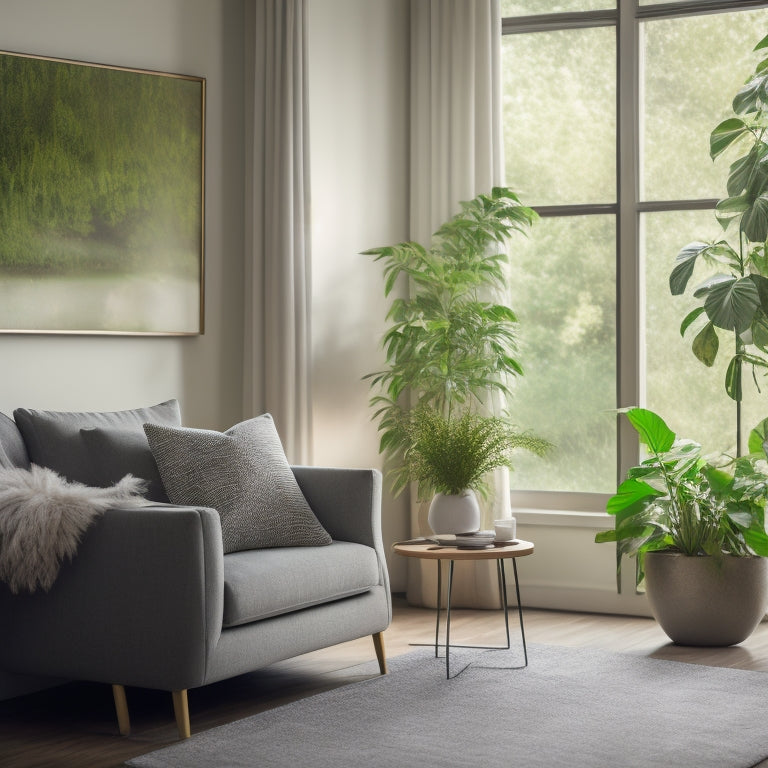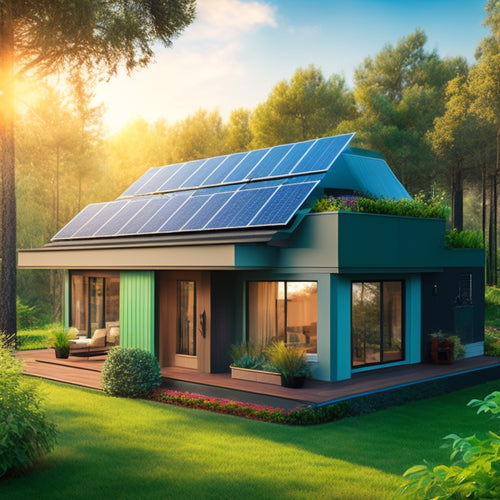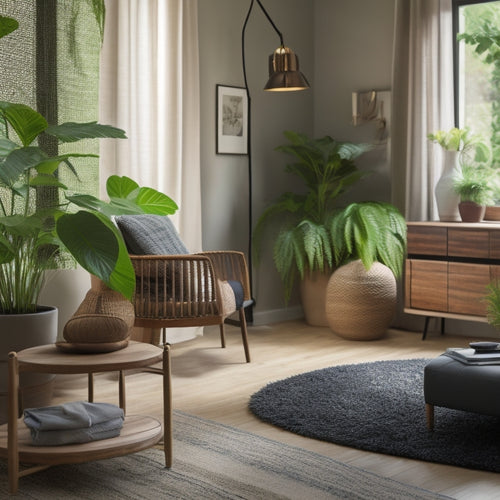
Green Home Air Purification: Your Step-by-Step Guide
Share
You're taking the first step towards creating a healthier living space by exploring green home air purification. It's vital to grasp that effective air purification involves more than just an air purifier, as it requires a thorough approach that incorporates eco-friendly technologies, ventilation strategies, and a profound comprehension of indoor air quality. You'll need to choose the right air filter, identify pollutant sources, and monitor air quality to guarantee a carbon-neutral lifestyle. As you move forward, you'll uncover the importance of maintaining ideal air quality and how to create a customized system that works in harmony with your unique space, ultimately leading you towards a cleaner, healthier home.
Key Takeaways
- Eco-friendly air purification options, such as plant-based purifiers and sustainable design, promote a carbon-neutral lifestyle and healthier living spaces.
- Identifying and mitigating pollutant sources, such as building materials and household pets, is crucial for improving indoor air quality.
- Choosing the right air filter, such as HEPA or activated carbon, and maintaining it properly is essential for optimal air quality.
- Continuous air quality monitoring and understanding AQI readings help identify air quality patterns and trends, enabling targeted actions.
- Implementing smart air purification systems with automated control and scheduling ensures cleaner air and improved air quality management.
Eco-Friendly Air Purification Options
Many households and offices rely on air purification systems to breathe easier, but some of these systems can harm the environment.
You're likely looking for eco-friendly air purification options that promote a healthier you and a healthier planet. Consider natural air filters or plant-based purifiers made from eco-friendly materials that employ green building materials and incorporate ventilation systems for improved air quality.
Opt for sustainable design and low emission products that reduce your carbon footprint. If you're handy, investigate DIY air solutions that make use of renewable resources.
Non-toxic alternatives and green technology can help you achieve a carbon neutral lifestyle. By choosing eco-friendly air purification options, you're taking a significant step towards a healthier and more sustainable living space.
Understanding Indoor Air Quality
Behind the walls of your home or office, a complex ecosystem of air pollutants, allergens, and gases can thrive, compromising your health and well-being.
You're likely unaware of the pollutants lurking in the air you breathe. These pollutants can originate from various sources, including building materials, furniture, and even your own activities.
Effective ventilation strategies are fundamental in removing stale air and introducing fresh air from outside. Additionally, humidity control plays an essential role in preventing the growth of mold and mildew.
Shifting to renewable energy sources like solar energy and incorporating green roofs can also contribute to a healthier indoor environment.
By understanding the indoor air quality in your space, you can take proactive steps to create a healthier environment. It's important to identify the sources of pollutants and develop strategies to mitigate their impact.
Choosing the Right Air Filter
You've identified the sources of pollutants in your indoor environment and developed strategies to mitigate their impact.
Now it's time to choose the right air filter to capture those pollutants. Curiously, just like electric cars offer a smoother, quieter ride, a good air filter can also contribute to a more comfortable and healthier living space electric car experience.
When selecting an air filter, consider the following factors:
- Filter types: HEPA, activated carbon, and ionizers are popular options, each with their strengths and weaknesses.
- Filter efficiency: Look for filters with high MERV ratings (11-13) or HEPA filters that capture 99.97% of particles as small as 0.3 microns.
- Filter size: Confirm the filter fits your air purifier or HVAC system properly.
- Maintenance and replacement: Choose filters with easy maintenance and replacement schedules to guarantee continuous performance.
Top Air Purification Technologies
Beyond the air filter, various air purification technologies can greatly enhance indoor air quality.
You'll want to evaluate HEPA filters, which capture 99.97% of particles as small as 0.3 microns, ensuring high filtration efficiency.
UV C technology is another effective method, using ultraviolet light to kill bacteria, viruses, and other germs.
Activated carbon can absorb gases, odors, and chemicals, while ozone generators can remove strong odors and pollutants.
Ionization methods and electrostatic precipitators can also capture particles and pollutants.
For a natural approach, air purifying plants can be used to remove toxins.
With the increasing focus on sustainability, renewable energy adoption is essential in creating a cleaner environment, and similarly, hybrid systems combining multiple technologies offer extensive air purification.
Additionally, photocatalytic oxidation can break down pollutants, making it a significant technology to evaluate.
Air Quality Monitor Essentials
You'll want to track the air quality levels in your space to guarantee your air purifier is effective, which means you'll need to understand how to monitor air quality levels, identify the sources of pollutants, and interpret AQI readings.
Adopting renewable energy sources, such as solar and wind power, can greatly reduce greenhouse gas emissions renewable energy adoption and contribute to a healthier environment.
These essential skills will help you optimize your air purifier's performance and create a healthier environment.
Monitoring Air Quality Levels
Monitoring air quality levels is crucial for maintaining a healthy indoor environment, as poor air quality can exacerbate respiratory issues and negatively impact overall well-being.
You need to stay on top of air quality trends to take control of your indoor air.
To do this effectively, consider the following:
-
Real-time monitoring: Look for an air quality monitor that provides real-time data, so you can respond quickly to changes in air quality.
-
Air quality indexes: Understand the air quality indexes used by your monitor, such as AQI, API, or IAQI, to accurately interpret the data.
-
Particle detection: Verify your monitor can detect a range of particles, including PM1, PM2.5, and PM10, to get a thorough overview of air quality.
- Data analysis: Choose a monitor that provides detailed data analysis, so you can identify patterns and trends in air quality over time.
Identifying Pollutant Sources
Identifying pollutant sources is an essential step in maintaining a healthy indoor environment, as it enables you to pinpoint and eliminate the root causes of poor air quality.
You need to investigate your home to identify potential sources of chemical pollutants, indoor allergens, and volatile compounds. Check for particulate matter from household pets, building materials, and environmental factors like seasonal changes.
Also, examine your home's moisture levels and air flow, as these can contribute to poor air quality. By doing so, you'll be able to identify the root causes of poor air quality and take targeted actions to eliminate them, ensuring a healthier and more comfortable living space.
Understanding AQI Readings
Now that you've pinpointed the pollutant sources in your home, it's time to quantify the air quality. Understanding AQI readings is essential for effective air purification. AQI, or Air Quality Index, is a numerical value that indicates the level of pollutants in the air.
To interpret AQI readings, follow these steps:
-
Know the AQI scale: AQI ranges from 0 to 500, with higher values indicating poorer air quality.
-
Identify the pollutant: AQI readings specify the pollutant being measured, such as PM2.5, PM10, or NO2.
-
Determine health impact: AQI interpretation techniques help you understand the health impact of the pollutant levels, from "good" to "hazardous".
- Take action: Based on the AQI reading, adjust your air purification strategy to reduce pollutant levels and protect your health.
Smart Air Purification Systems
You're now exploring the domain of smart air purification systems, which take air quality monitoring to the next level.
These systems integrate smart sensors that continuously track pollutants, allowing for automated purification control that adjusts to changing air quality conditions.
Air Quality Monitoring
Three key components of smart air purification systems are air quality monitoring, automatic fan speed adjustment, and real-time feedback.
You're probably wondering what air quality monitoring entails. It's an essential feature that continuously tracks and reports the air quality in your home, ensuring you're always aware of the air you breathe. This feature is especially important for individuals with respiratory issues or those who want to minimize their environmental impact.
Here are four ways air quality monitoring benefits you:
- Real-time pollution detection: Receive instant alerts when air quality drops, allowing you to take action.
- Customizable alerts: Set thresholds for specific pollutants, such as PM2.5 or VOCs, to stay informed.
- Historical data tracking: Analyze air quality trends to identify patterns and optimize your purification strategy.
- Optimized filter replacement: Get notified when filters need replacement, ensuring your system operates efficiently.
Automated Purification Control
As air quality monitoring provides you with essential information about your indoor air, automated purification control takes it to the next level by responding to pollution fluctuations.
With automated scheduling, you can set your air purifier to run at specific times or intervals, ensuring your air is clean when you need it most. This feature is especially useful for people with busy schedules or those who want to save energy.
Additionally, remote control capabilities allow you to adjust your air purifier's settings from anywhere, giving you complete freedom to manage your indoor air quality. This smart feature enables you to respond promptly to changes in air quality, ensuring a healthier breathing environment.
Smart Sensors Integration
When you're relying on automated purification control, smart sensors integration enhances your air purification system to a whole new level.
This technology allows for real-time monitoring and data analysis, ensuring your system is always optimized for maximum efficiency.
With smart sensors, you can:
- Detect pollutant levels: Receive accurate readings of PM2.5, PM10, and other pollutants in your air.
- Adjust fan speed: Automatically adjust fan speed based on pollutant levels for maximum efficiency.
- Monitor filter life: Get notifications when filters need replacement, ensuring your system always runs at peak performance.
- Track air quality trends: Analyze data to identify patterns and optimize your purification system for better results.
Maintaining Optimal Air Quality
How do you guarantee the air in your home or office remains clean and healthy to breathe? You need to implement effective ventilation strategies to remove stale air and bring in fresh air from outside. This is vital in maintaining ideal air quality.
Additionally, humidity control is necessary to prevent mold growth and moisture buildup. You can achieve this by using a dehumidifier or humidifier, depending on your climate.
Regularly cleaning your air purifier's filter and replacing it as needed will also guarantee optimal performance.
Frequently Asked Questions
Can I Use an Air Purifier in a Room With a Pet?
Imagine your furry friend snuggled up beside you, but their dander and fur sheddings polluting the air. Yes, you can use an air purifier in a room with a pet to capture pet allergens, greatly improving air quality for a fresher, healthier space.
Will Air Purifiers Remove Unpleasant Odors From the Air?
You'll be relieved to know that air purifiers can effectively remove unpleasant odors from the air, targeting sources like pets, smoke, and cooking, thereby improving your indoor air quality and giving you the freedom to breathe easy.
Do Air Purifiers Work With Open Windows or Doors?
When you run an air purifier with open windows or doors, you'll compromise its airflow effectiveness, allowing outdoor pollutants to enter and reducing its ability to remove impurities, so it's best to use it in a sealed space for ideal performance.
Can I Move an Air Purifier From Room to Room?
You're a freedom-seeker who demands pristine air quality wherever you roam! Yes, you can move an air purifier from room to room, but consider the room size and its air quality needs to guarantee peak performance and maximum freshness.
How Often Should I Clean My Air Purifier's Filter?
You'll need to clean your air purifier's filter every 1-3 months, depending on usage and manufacturer guidelines, to maintain its efficiency; establish a replacement schedule to guarantee peak performance and air quality.
Related Posts
-

3 Green HVAC Filters for Solar-Powered Homes
When outfitting your solar-powered home with an HVAC system, you'll want to choose filters that align with your commi...
-

10 Eco-Friendly Air Management Tools for Clean Home Living
You're taking an essential step towards creating a healthier living space by seeking eco-friendly air management tool...
-

10 Powerful Electric Mowers for Expansive Lawns
You're moving away from gas-powered mowers and exploring electric options for your expansive lawn. You'll find that h...


